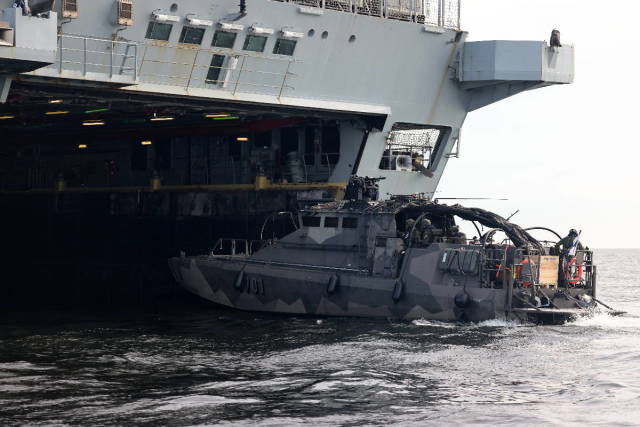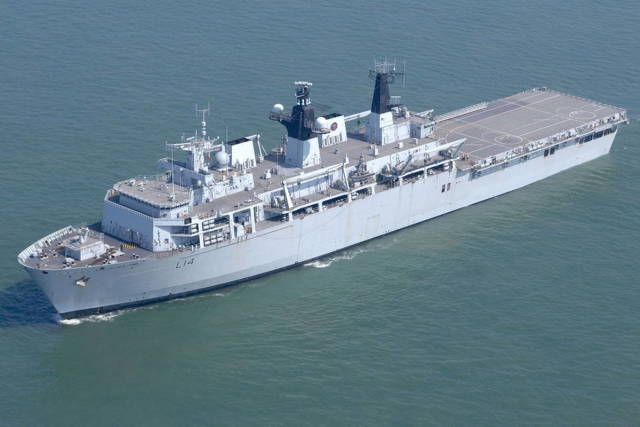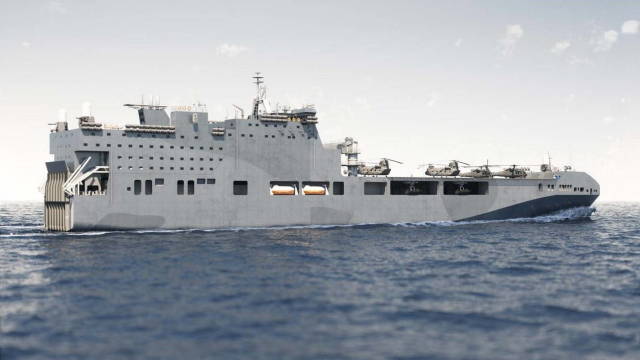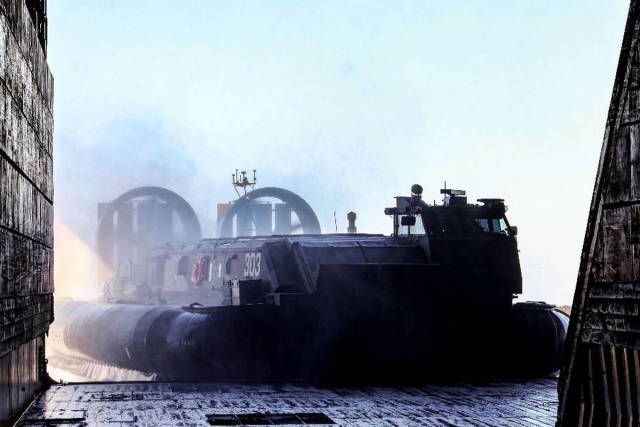In the document of the British military command of 2021, the Coastal Response Group (LRG, Littoral Response Group; hereinafter referred to as the PGR) is defined as "specialized forces [in the structure of the British Navy] assigned to a geographical area, which includes special ships, boats and helicopters."
 |
| Source: invoen.ru |
Author: Harry Lye (Harry Lye) – senior reporter on naval topics of the cited resource. Studies programs, requirements for ships of the future and the possibilities of promising technologies.
[The translation is made with the preservation of the author's style. Editorial explanations are taken in square brackets]
The transformation of the amphibious potential of the British Navy into the PGR format was accompanied by investments worth millions of pounds in the development of Promising Commando Forces (Future Commando Force) capable of responding more quickly to threats arising from the sea. PGR appear when the Navy is increasing its presence around the world with a return to carrier strike operations and direct use of coastal patrol ships (offshore patrol vessel, OPV).
The essence of the concept
In 2021, during the deployment of the LRG North in the Baltic Sea, the Royal Marines (RM) demonstrated how the amphibious helicopter dock ship (LPD) HMS Albion (Albion type) and the amphibious dock ship (LSD (A)) Mounts (Buy type") of the Royal Navy Auxiliary (RFA) operated with periodic support from the Type 23 frigate HMS Lancaster of the Duke project. The culmination of their work was the multinational exercises BALTOPS.
This format of two amphibious ships plus escorts is at the core of the concept, ensuring the presence of commando units, boats, aviation and increasingly numerous uninhabited air and surface vessels on the water.
In 2023, these capabilities will be consistently expanded to the Indo-Pacific region, and the deployment of the PGR to the southeast of Suez will be carried out from the port of Duqm (Duqm, Oman). In fact, this will give the British Navy a permanent amphibious capability, while the area of responsibility of the PGR "North" will cover the North Atlantic and the seas around Europe, and the PGR "South" (LRG South) will be based in the Middle East with the possibility of penetration into the Indo-Pacific region.

The Finnish Jehu-class amphibious assault ship enters the dock of HMS Albion during the deployment of LRG North in 2021
Answering the question about what such capabilities the PGR will provide to the UK that other forms of amphibious groups have not done this, the deputy commander of the 3rd Commando Brigade, Colonel Chris Haw, said that the new model of increased stability provides defense with a "higher level of readiness."
"Previously, according to the model of the lead Commando group, we had only one commando unit in a state of readiness that could be deployed, but now we are talking about two simultaneous permanent forward operational formations," explained K. Hou. Based at sea [by ship] or on land, these elements give the Government more political choice and the ability to respond to national security challenges, humanitarian or other emergencies.
The commando elements in the PGR originate from the 3rd Commando Brigade, which draws its strength from the Royal Marines and units of the British Army, Air Force and Navy, concentrated around the 40th and 45th Commandos [units equivalent to a battalion]. The impactor itself, as the core of the PGR, has a strength of about 500 people. In addition to this core of personnel, the structure of the PGR includes ships, boats and aircraft necessary to support operations.
While BALTOPS 2021 was an important event on the way to transforming amphibious capabilities into a PGR format, the upcoming formation of the PGR "South" in 2023 is a critical moment. "With the help of the South 23 PGR, we will begin to carry out such advanced operations in the structures that our concept of use suggests," said K. Hou.
He explained that these efforts were a "root" representation of how British commando forces achieve their results and strategic effects, adding that in 2023 it will be possible to see the maximum degree of effort. The tasks assigned to the groups will vary from mission to mission. However, the nature of the waters in which they will operate suggests that they will undoubtedly be diverse.
According to K. Howe, the configuration of the "North" PGR is much more oriented towards NATO and will focus on such events as large-scale exercises Cold Response or, for example, BALTOPS. As a result, the units and commandos associated with the "North" PGR conduct training in cold and extremely cold weather conditions. Despite this, K. Hou will add: "... commandos and auxiliary elements from aircraft and boats will generally be the same, although the platforms will be slightly different."
Another aspect of the PGR is their ability to transform into an expeditionary strike group by combining forces with an aircraft carrier strike group. In response to the report of the Defense Committee of the British Parliament, it was stated that the concept of expeditionary strike forces is planned to be implemented in 2022, in order to study how these two formations can support each other.
Current amphibious capabilities of the British Navy
Today, the amphibious capabilities of the British Navy are concentrated around two Albion-type LPD and three Buy-type LSD(A) of the auxiliary fleet. While the UK has two ships of the Albion project, only Albion is active, since another ship of this project, HMS Bulwark, is currently in a "state of optimized support" and will not return to the fleet again until 2024. Then it will become the amphibious flagship of the British Navy.

Amphibious helicopter dock ship HMS Albion of the British Navy
Working on Bulwark will give him another ten years of service. Bulwark in one form or another has been in extended readiness since 2017, and Albion's return to service will require repairs worth 80 million pounds (107.43 million US dollars).
With a total displacement of 19,650 tons, the Albion project can accommodate 67 vehicles and accommodate 405 marines. The ships can deliver equipment to shore through their docking chamber and a flight deck capable of carrying two Chinook helicopters. However, the limitation of these ships is the lack of a hangar, which is why the landed aircraft cannot be properly sheltered. According to the Minister of Defense Procurement of the United Kingdom, Jeremy Quin, both Albion and Bulwark will retire by the end of 2034.
In the type "Buy" RFA, according to the media, there is a place to transport 37 MBT "Challenger", 150 light trucks, plus 200 tons of ammunition, 12×40 TEU or 24×20 TEU containers and 356 military personnel. The material part can be delivered by helicopters from the ship's side deck, through the amphibious dock and from the onboard davits. The ships also have two 30-ton cranes, providing more flexibility.
Initially, the UK built four LSD (A) "Buy" projects, but in 2011 decommissioned one, selling it to Australia, where it remains in service with the Royal Australian Navy.
Justin Hedges, former deputy commander of the special forces of the United Kingdom, and currently founding partner and executive chairman of Prevail Partners, which developed the project of a multifunctional coastal marine strike ship [Multi-Role Vessel Littoral Strike Ship], said that the payload capacity of the PGR is limited to boats and helicopters that accommodate people for a long time time. At the same time, he added, they provide a basis for connecting other countries.

Multifunctional attack ship of the coastal marine zone. Prevail Sketch
In 2019, the UK announced plans to acquire two coastal marine strike ships. However, over time, the program seems to have run out of steam. The multifunctional ship from Prevail is based on a PoPo FSG 4100 type commercial vessel, and its design includes a hangar and aviation facilities that can accommodate six Chinook or Merlin-sized helicopters [EH-101 Merlin].
Like the Albion type, the Bai project also does not have a permanent hangar, which complicates the landing of helicopters. In the Defense Command Paper, the United Kingdom announced plans worth 50 million pounds to refit a Bai-type ship to better support coastal strike operations. The result of this work is likely to be the expansion of the hangar and the aircraft capabilities of the ship.
Commenting on the prospects for transformation, a representative of the British Navy told the source: "Plans are being developed to allow ships of the Bai type to operate exclusively with PGR, and a Comprehensive review approved the program of a multifunctional support ship [Multi-Role Support Ship, MRSS], which will ensure the maintenance of the potential in the long term."
In September 2021, a source said that the fleet has no deadlines regarding the conversion of the project "Buy" worth 50 million pounds. According to a representative of the British Navy: "... there is an intention to refit a Bai-type support ship for coastal strike operations. No decision has been made on the schedule of this transformation."
According to experts, the likely candidates for the conversion of a coastal strike will be either the Mounts ship or the Cardigan. The work is likely to include improving C2 [command and control] capabilities and launching autonomous systems, which are of growing interest to the Royal Navy.
"Platforms are really important for the concept of the PGR, because they provide a maritime operational maneuver so that we can interact with partner forces, but without the need to lay infrastructure in a particular country, which means that we can also move towards an emerging threat. But, ultimately, it is not so important what type of ship, if it has a communication infrastructure, it can control helicopters, etc.," said K. Hou. He added that the PGR will work with the OPV type Batch II project "River" of the British Navy.
To be continued...
Based on the materials of the resource editions.shephardmedia.com
The materials of the article contain exclusively author's estimates and do not reflect the position of the editorial board of the IVi

